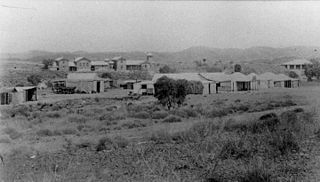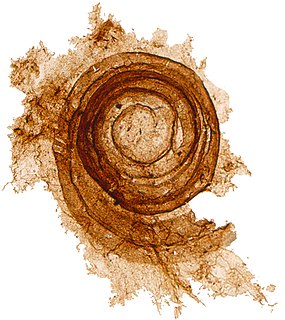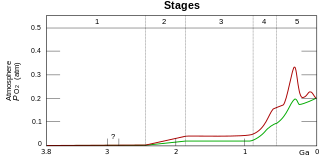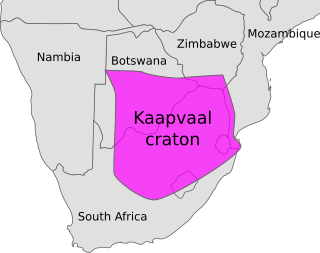
The Proterozoic is a geological eon spanning the time interval from 2500 to 538.8 million years ago. It is the most recent part of the Precambrian "supereon". It is also the longest eon of the Earth's geologic time scale, and it is subdivided into three geologic eras : the Paleoproterozoic, Mesoproterozoic, and Neoproterozoic.

The Archean Eon is the second of four geologic eons of Earth's history, representing the time from 4,000 to 2,500 million years ago. In this time, the Earth's crust had cooled enough for continents to form and for the earliest known life to start. Life was simple throughout the Archean, mostly represented by shallow-water microbial mats called stromatolites, and the atmosphere lacked free oxygen. The Archean was preceded by the Hadean Eon and followed by the Proterozoic.

Marble Bar is a town and rock formation in the Pilbara region of north-western Western Australia. Its extremely hot climate, with a mean maximum temperature second only to Wyndham, Western Australia has resulted in the town being well known for its hot weather.

A microfossil is a fossil that is generally between 0.001 mm and 1 mm in size, the visual study of which requires the use of light or electron microscopy. A fossil which can be studied with the naked eye or low-powered magnification, such as a hand lens, is referred to as a macrofossil.
The Mesoarchean is a geologic era in the Archean Eon, spanning 3,200 to 2,800 million years ago, which contains the first evidence of modern-style plate subduction and expansion of microbial life. The era is defined chronometrically and is not referenced to a specific level in a rock section on Earth.
The Paleoarchean, also spelled Palaeoarchaean, is a geologic era within the Archaean Eon. The name derives from Greek "Palaios" ancient. It spans the period of time 3,600 to 3,200 million years ago. The era is defined chronometrically and is not referenced to a specific level of a rock section on Earth. The earliest confirmed evidence of life comes from this era, and Vaalbara, one of Earth's earliest supercontinents, may have formed during this era.

The Gunflint chert is a sequence of banded iron formation rocks that are exposed in the Gunflint Range of northern Minnesota and northwestern Ontario along the north shore of Lake Superior. The Gunflint Chert is of paleontological significance, as it contains evidence of microbial life from the Paleoproterozoic. The Gunflint Chert is composed of biogenic stromatolites. At the time of its discovery in the 1950s, it was the earliest form of life discovered and described in scientific literature, as well as the earliest evidence for photosynthesis. The black layers in the sequence contain microfossils that are 1.9 to 2.3 billion years in age. Stromatolite colonies of cyanobacteria that have converted to jasper are found in Ontario. The banded ironstone formation consists of alternating strata of iron oxide-rich layers interbedded with silica-rich zones. The iron oxides are typically hematite or magnetite with ilmenite, while the silicates are predominantly cryptocrystalline quartz as chert or jasper, along with some minor silicate minerals.

The Great Oxidation Event (GOE), also called the Great Oxygenation Event, the Oxygen Catastrophe, the Oxygen Revolution, and the Oxygen Crisis, was a time interval when the Earth's atmosphere and the shallow ocean first experienced a rise in the amount of oxygen. This occurred approximately 2.4–2.0 Ga (billion years) ago, during the Paleoproterozoic era. Geological, isotopic, and chemical evidence suggests that biologically-produced molecular oxygen (dioxygen, O2) started to accumulate in Earth's atmosphere and changed it from a weakly reducing atmosphere practically free of oxygen into an oxidizing atmosphere containing abundant oxygen.

The Isua Greenstone Belt is an Archean greenstone belt in southwestern Greenland, aged between 3.7 and 3.8 billion years. The belt contains variably metamorphosed mafic volcanic and sedimentary rocks, and is the largest exposure of Eoarchaean supracrustal rocks on Earth. Due to its age and low metamorphic grade relative to many Eoarchaean rocks, the Isua Greenstone Belt has become a focus for investigations on the emergence of life and the style of tectonics that operated on the early Earth.
Biotic material or biological derived material is any material that originates from living organisms. Most such materials contain carbon and are capable of decay.
The early Earth is loosely defined as Earth in its first one billion years, or gigayear (Ga, 109y). The “early Earth” encompasses approximately the first gigayear in the evolution of our planet, from its initial formation in the young Solar System at about 4.55 Ga to sometime in the Archean eon at about 3.5 Ga. On the geologic time scale, this comprises all of the Hadean eon (starting with the formation of the Earth about 4.6 billion years ago), as well as the Eoarchean (starting 4 billion years ago) and part of the Paleoarchean (starting 3.6 billion years ago) eras of the Archean eon.

Vaalbara was an Archean supercontinent consisting of the Kaapvaal Craton and the Pilbara Craton. E. S. Cheney derived the name from the last four letters of each craton's name. The two cratons consist of crust dating from 2.7 to 3.6 Gya, which would make Vaalbara one of Earth's earliest supercontinents.

The Kaapvaal Craton, along with the Pilbara Craton of Western Australia, are the only remaining areas of pristine 3.6–2.5 Ga crust on Earth. Similarities of rock records from both these cratons, especially of the overlying late Archean sequences, suggest that they were once part of the Vaalbara supercontinent.

The Pilbara Craton is an old and stable part of the continental lithosphere located in the Pilbara region of Western Australia.

The Barberton Greenstone Belt is situated on the eastern edge of Kaapvaal Craton in South Africa. It is known for its gold mineralisation and for its komatiites, an unusual type of ultramafic volcanic rock named after the Komati River that flows through the belt. Some of the oldest exposed rocks on Earth are located in the Barberton Greenstone Belt of the Eswatini–Barberton areas and these contain some of the oldest traces of life on Earth. Only the rocks found in the Isua Greenstone Belt of Western Greenland are older. The Makhonjwa Mountains make up 40% of the belt.

The Warrawoona Group is a geological unit in Western Australia containing putative fossils of cyanobacteria cells. Dated 3.465 Ga, these microstructures, found in Archean chert, are considered to be the oldest known geological record of life on Earth.
This timeline of natural history summarizes significant geological and biological events from the formation of the Earth to the arrival of modern humans. Times are listed in millions of years, or megaanni (Ma).
James William Schopf is an American paleobiologist and professor of earth sciences at the University of California Los Angeles. He is also Director of the Center for the Study of Evolution and the Origin of Life, and a member of the Department of Earth and Space Sciences, the Institute of Geophysics and Planetary Physics, and the Molecular Biology Institute at UCLA. He is most well known for his study of Precambrian prokaryotic life in Australia's Apex chert. Schopf has published extensively in the peer reviewed literature about the origins of life on Earth. He is the first to discover Precambrian microfossils in stromatolitic sediments of Australia (1965), South Africa (1966), Russia (1977), India (1978), and China (1984). He served as NASA's principal investigator of lunar samples during 1969–1974.

The Fig Tree Formation, also called Fig Tree Group, is a stromatolite-containing geological formation in South Africa. The rock contains fossils of microscopic life forms of about 3.26 billion years old. Identified organisms include the bacterium Eobacterium isolatus and the algae-like Archaeosphaeroides barbertonensis. The fossils in the Fig Tree Formation are considered some of the oldest known organisms on Earth, and provide evidence that life may have existed much earlier than previously thought. The formation is composed of shales, turbiditic greywackes, volcaniclastic sandstones, chert, turbiditic siltstone, conglomerate, breccias, mudstones, and iron-rich shales.

The earliest known life forms on Earth are putative fossilized microorganisms found in hydrothermal vent precipitates, considered to be about 3.42 billion years old. The earliest time for the origin of life on Earth is at least 3.77 billion years ago, possibly as early as 4.28 billion years, or even 4.41 billion years—not long after the oceans formed 4.5 billion years ago, and after the formation of the Earth 4.54 billion years ago. The earliest direct evidence of life on Earth is from microfossils of microorganisms permineralized in 3.465-billion-year-old Australian Apex chert rocks.













